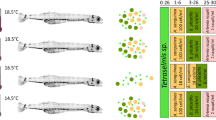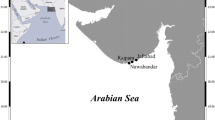Abstract
Seasonal changes in the growth rate of larval Japanese anchovy Engraulis japonicus collected by shirasu seine net boats in Osaka Bay in 2008 were estimated using otolith daily growth increments to examine the effects of environmental factors. Larval anchovy were caught from May to November. The range in standard length (SL) of the larval anchovy was 10–35 mm, and larvae of SL 20–25 mm dominated numerically, accounting for more than 40% of all anchovy larvae. Daily growth rates for the last five days before catch increased from May to July, decreased or were stagnant in August and September, increased again in October, and decreased in November. Seawater temperature and density of copepod nauplii were correlated with the daily growth rate. In this study, the relationship between growth rate and temperature showed a skewed dome shape, with an optimum temperature for growth of around 23 °C. These results in summer of 2008 suggest that the growth rate of Japanese anchovy increased with increasing temperature for temperatures < 23 °C, but growth was limited by prey availability and/or other factors, such as low dissolved oxygen, at higher temperatures. Recent environmental improvements in nutrient inputs to Osaka Bay are discussed in relation to larval growth rate.










Similar content being viewed by others
References
Akaike H (1973) Information theory and an extension of the maximum likelihood principle. In: Petrov BN, Caski F (eds) Proceedings of the 2nd International Symposium on Information Theory. Akadimiai Kiado, Budapest, pp 267–281
Campana SE (1990) How reliable are growth back-calculations based on otoliths? Can J Fish Aquat Sci 47:2219–2227
Fujiwara T, Kishimoto A, Nakajima M (2004) Long and short term variations in hypoxic water in Osaka Bay. Proc Coast Eng 51:931–935 (in Japanese)
Fukuhara O (1983) Development and growth of laboratory reared Engraulis japonica (Houttuyn) larvae. J Fish Biol 23:641–652
Fukunaga M, Hama S, Imoto E, Jyanome I, Kusumoto T, Noichi K, Imaji Y, Nagaoka H (1997) Heisei 7 nendo shigenkanrigata gyokaikyou yosoku gijutsu kaihatsu shiken (test of resource management type developing fishing and sea condition prediction technology). In: Heisei 7 nendo fisheries experimental station jigyou houkokusyo. Tokushima Prefecture, Tokushima, pp 140–148. http://www.pref.tokushima.jp/tafftsc/suisan/material/business_report/jigyou_h7.html#6 (in Japanese)
Hewitt RP, Theilacker GH, Lo NC (1985) Causes of mortality in young jack mackerel. Mar Ecol Prog Ser 26:1–10
Houde ED (1989) Comparative growth, mortality, and energetics of marine fish larvae: temperature and implied latitudinal effects. Fish Bull 87:471–495
Imai T, Tanaka I (1987) Effect of sea water temperature on egg size of Japanese Anchovy. Nippon Suisan Gakkaishi 53:2169–2178
Joh H (1986) Studies on the mechanism of eutrophication and the effect of it on fisheries production in Osaka Bay. Bull Osaka Prefect Fish Exp Stat 7:1–174 (in Japanese)
Leak JC, Houde ED (1987) Cohort growth and survival of bay anchovy Anchoa mitchilli larvae in Biscayne Bay, Florida. Mar Ecol Prog Ser 37:109–122
Mitani T (1988) Food habits of Japanese anchovy in the shirasu fishing ground within Sagami Bay. Nippon Suisan Gakkaishi 54:1859–1865 (in Japanese with English abstract)
Oozeki Y, Zenitani H (1996) Factors affecting the recent growth of Japanese sardine larvae (Sardinops melanostictus) in the Kuroshio Current. In: Watanabe T et al (eds) Survival strategies in early life stages of marine resources. A.A. Balkema, Rotterdam, pp 95–104
Tada K, Yamamoto K, Ichimi K, Yamamda M, Nishikawa T, Tarutani K, Yamaguchi K (2012) Seasonal and annual variations of phytoplankton assemblage and its environmental factor in Osaka Bay, Seto Inland Sea, Japan. Setonaikai 64:75–77 (in Japanese)
Takahashi M, Watanabe Y (2002) Recruitment probability depending on larval growth rate in the Japanese anchovy, Engraulis japonicus. Fish Sci 68:222–225
Takahashi M, Watanabe Y (2004) Growth rate-dependent recruitment of Japanese anchovy Engraulis japonicus in the Kuroshio–Oyashio transitional waters. Mar Ecol Prog Ser 266:227–238
Takahashi M, Watanabe Y, Kinoshita T, Watanabe C (2001) Growth of larval and early juvenile Japanese anchovy, Engraulis japonicus, in the Kuroshio–Oyashio transition region. Fish Oceanogr 10:235–247
Takao K (1990) Migration and spawning of anchovy in the Seto Inland Sea. Suisan Gijyutu To Keiei 3:9–17 (in Japanese)
Takasuka A, Aoki I (2006) Environmental determinants of growth rates for larval Japanese anchovy Engraulis japonicus in different waters. Fish Oceanogr 15:139–149
Takasuka A, Aoki I, Mitani I (2003) Evidence of growth-selective predation on larval Japanese anchovy Engraulis japonicus in Sagami Bay. Mar Ecol Prog Ser 252:223–238
Takasuka A, Oozeki Y, Aoki I (2007) Optimal growth temperature hypothesis: why do anchovy flourish and sardine collapse or vice versa under the same ocean regime? Can J Fish Aquat Sci 64:768–776
Takasuka A, Oozeki Y, Aoki I, Kimura R, Kubota H, Sugisaki H, Akamine T (2008) Growth effect on the otolith and somatic size relationship in Japanese anchovy and sardine larvae. Fish Sci 74:308–313
R Core Team (2013) R: a language and environment for statistical computing. R Foundation for Statistical Computing, Vienna. http://www.R-project.org/
Theilacker GH (1980) Changes in body measurements of larval northern anchovy, Engraulis mordax, and other fishes due to handling and preservation. Fish Bull 78:685–692
Tsuji S, Aoyama T (1984) Daily growth increments in otoliths of Japanese anchovy Engraulis japonica. Nippon Suisan Gakkaishi 50:1105–1108
Tsujino K, Watari T (2001) Daily growth of Japanese anchovy larvae Engraulis japonica in Osaka Bay. Bull Osaka Prefect Fish Exp Stat 13:11–18 (in Japanese)
Uotani I (1985) The relation between feeding mode and feeding habitat of the anchovy larvae. Nippon Suisan Gakkaishi 51:1057–1065 (in Japanese with English abstract)
Wang YT, Tzeng WN (1999) Differences in growth rates among cohorts of Encrasicholina punctifer and Engraulis japonicus larvae in the coastal waters off Tanshui River Estuary, Taiwan, as indicated by otolith microstructure analysis. J Fish Biol 54:1002–1016
Watanabe Y, Ochiai S, Fukamichi K (2014) Larval growth rates differ in response to seasonal temperature variations among clupeoid species inhabiting the Pacific coastal waters of Japan. Fish Sci 80:43–51
Yamamoto T (2003) The Seto Inland Sea—eutrophic or oligotrophic? Mar Poll Bull 47:37–42
Yamamoto K, Nakajima M, Tsujino K (1997) Vertical distribution of fish eggs and larvae in Osaka Bay. Bull Osaka Prefect Fish Exp Stn 10:1–17 (in Japanese)
Yamashita Y, Tanaka M, Miller JM (2001) Ecophysiology of juvenile flatfish in nursery grounds. J Sea Res 45:205–218
Yasue N, Takasuka A (2009) Seasonal variability in growth of larval Japanese anchovy Engraulis japonicus in the Kii Channel, Japan. J Fish Biol 74:2250–2268
Yokoyama H, Sano M (2015) Zoning of Osaka Bay based on principal component analysis of sediment parameters and comparison between the 2013 and previous surveys. Nippon Suisan Gakkaishi 81:68–80 (in Japanese with English abstract)
Zenitani H, Kono N, Tsukamoto Y (2007) Relationship between daily survival rates of larval Japanese anchovy (Engraulis japonicus) and concentrations of copepod nauplii in the Seto Inland Sea, Japan. Fish Oceanogr 16:473–478
Zenitani H, Kono N, Tsukamoto Y, Masuda R (2009) Effects of temperature, food availability, and body size on daily growth rate of Japanese anchovy Engraulis japonicus larvae in Hiuchi-nada. Fish Sci 75:1177–1188
Acknowledgements
We express our sincere thanks to T. Tsuji, E. Ohmichi, H. Ikeda, and the crew of the R/V Osaka for their support during our field research in Osaka Bay. We are grateful to the fishermen of Fuke and Kishiwada Fisheries Cooperative for allowing us to sample Japanese anchovy larvae. We also thank colleagues at the Marine Fisheries Research Center, Research Institute of Environment, Agriculture and Fisheries, Osaka Prefecture for their helpful comments.
Author information
Authors and Affiliations
Corresponding author
Rights and permissions
About this article
Cite this article
Yamamoto, K., Saito, M. & Yamashita, Y. Relationships between the daily growth rate of Japanese anchovy Engraulis japonicus larvae and environmental factors in Osaka Bay, Seto Inland Sea, Japan. Fish Sci 84, 373–383 (2018). https://doi.org/10.1007/s12562-018-1178-5
Received:
Accepted:
Published:
Issue Date:
DOI: https://doi.org/10.1007/s12562-018-1178-5




